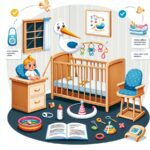Choosing the safest baby car seats for newborns is one of the most critical decisions parents will make, ensuring their little one’s safety during car journeys. With an overwhelming array of options, finding the best and safest car seat seems daunting. However, armed with the right knowledge, you can make an informed choice that combines safety, comfort, and convenience.
Understanding Car Seat Safety Standards
Before diving into the myriad of car seat options, it’s essential to understand the safety standards that govern them. These standards are designed to ensure that all car seats meet minimum safety criteria to protect your baby in the event of a crash. The National Highway Traffic Safety Administration (NHTSA) offers guidelines and ratings that can help parents assess the safety of car seats. Checking for a seat’s NHTSA rating is a good starting point in your search.
Moreover, it’s crucial to recognize that car seats come with an expiration date. Materials degrade over time, and safety standards evolve, making it important to use a current model that adheres to the latest guidelines. For this reason, experts advise against using second-hand car seats unless you are certain of their history and they meet current safety standards.
Choosing the Safest Baby Car Seats for Newborns
When selecting a car seat for your newborn, the first consideration should be the type of car seat. Infant car seats are specifically designed for newborns and young babies. These seats are rear-facing, the position recommended by safety experts to protect your baby’s head, neck, and spine in the event of a crash. A good practice is to keep your child in a rear-facing seat for as long as possible, at least until they reach the seat’s maximum height and weight limit.
Another key factor is the car seat’s installation system. Many modern car seats come equipped with the LATCH system (Lower Anchors and Tethers for CHildren), which simplifies car seat installation and ensures a tighter, more secure fit. However, not all vehicles are compatible with LATCH, so it’s important to check your car’s manual and the car seat specifications before making a purchase.
Additional Safety Features to Consider
Beyond the basic requirements, several additional safety features can enhance protection for your newborn. Side-impact protection, for example, offers extra padding and energy-absorbing materials on the sides of the car seat to shield your baby in the event of a side-impact collision. An adjustable 5-point harness system is also crucial, as it securely holds your baby in the safest position during a crash.
It’s also worth considering a car seat with an adjustable base or one that comes with multiple recline positions. This feature can help achieve the correct angle for your newborn, ensuring they are not only safe but also comfortable, reducing the risk of oxygen desaturation. Remember, the right car seat is one that fits your baby, fits your car, and is one that you can install and use correctly every time.
In conclusion, choosing the safest baby car seats for newborns requires thorough research, understanding of safety standards, and consideration of your particular needs. By prioritizing safety features, ease of installation, and proper fit for your baby and vehicle, you can select a car seat that offers peace of mind while on the road. Don’t forget to regularly check for recalls and to transition to a larger seat as your child grows to maintain optimal safety.
For more information on baby safety and care, visit our articles on Safe Sleep Practices to Reduce the Risk of SIDS, First Aid for Choking in Infants: Crucial Steps Every Parent Should Know, and Car Seat Safety Checks Every Parent Should Perform for additional insights and tips.
For a comprehensive guide on car seat safety and installation, consider visiting the National Highway Traffic Safety Administration (NHTSA) website. Their resources can provide you with the up-to-date information needed to make the best choice for your family.













